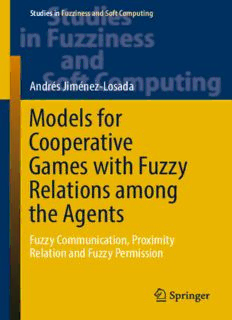
Models for Cooperative Games with Fuzzy Relations among the Agents PDF
Preview Models for Cooperative Games with Fuzzy Relations among the Agents
Studies in Fuzziness and Soft Computing Andrés Jiménez-Losada Models for Cooperative Games with Fuzzy Relations among the Agents Fuzzy Communication, Proximity Relation and Fuzzy Permission Studies in Fuzziness and Soft Computing Volume 355 Series editor Janusz Kacprzyk, Polish Academy of Sciences, Warsaw, Poland e-mail: [email protected] About this Series The series “Studies in Fuzziness and Soft Computing” contains publications on various topics in the area of soft computing, which include fuzzy sets, rough sets, neural networks, evolutionary computation, probabilistic and evidential reasoning, multi-valuedlogic,andrelatedfields.Thepublicationswithin“StudiesinFuzziness and Soft Computing” are primarily monographs and edited volumes. They cover significant recent developments in the field, both of a foundational and applicable character. An important feature of the series is its short publication time and world-wide distribution. This permits a rapid and broad dissemination of research results. More information about this series at http://www.springer.com/series/2941 é é Andr s Jim nez-Losada Models for Cooperative Games with Fuzzy Relations among the Agents Fuzzy Communication, Proximity Relation and Fuzzy Permission 123 Andrés Jiménez-Losada Departamento deMatemática AplicadaII Universidad deSevilla Seville Spain ISSN 1434-9922 ISSN 1860-0808 (electronic) Studies in FuzzinessandSoft Computing ISBN978-3-319-56471-5 ISBN978-3-319-56472-2 (eBook) DOI 10.1007/978-3-319-56472-2 LibraryofCongressControlNumber:2017936324 ©SpringerInternationalPublishingAG2017 Thisworkissubjecttocopyright.AllrightsarereservedbythePublisher,whetherthewholeorpart of the material is concerned, specifically the rights of translation, reprinting, reuse of illustrations, recitation, broadcasting, reproduction on microfilms or in any other physical way, and transmission orinformationstorageandretrieval,electronicadaptation,computersoftware,orbysimilarordissimilar methodologynowknownorhereafterdeveloped. The use of general descriptive names, registered names, trademarks, service marks, etc. in this publicationdoesnotimply,evenintheabsenceofaspecificstatement,thatsuchnamesareexemptfrom therelevantprotectivelawsandregulationsandthereforefreeforgeneraluse. The publisher, the authors and the editors are safe to assume that the advice and information in this book are believed to be true and accurate at the date of publication. Neither the publisher nor the authorsortheeditorsgiveawarranty,expressorimplied,withrespecttothematerialcontainedhereinor for any errors or omissions that may have been made. The publisher remains neutral with regard to jurisdictionalclaimsinpublishedmapsandinstitutionalaffiliations. Printedonacid-freepaper ThisSpringerimprintispublishedbySpringerNature TheregisteredcompanyisSpringerInternationalPublishingAG Theregisteredcompanyaddressis:Gewerbestrasse11,6330Cham,Switzerland A book, as a journey, begins with concern and it ends with melancholy José Vasconcelos To my wife and my daughters, thanks for being capable of putting up with me. Foreword Cooperative game theory can be seen as an axiomatic approach to analyze situa- tions in which the players can make coalitions with worth. In a cooperative game with transferable utility, the worth of a coalition is the maximal profit or the minimal cost for the players in their own coalition. A solution concept is a distri- butionoftheprofit(cost)ofthegreatcoalitionamongtheplayers.Stablesets,core, kernel, and several types of values are solution concepts, but I believe that the Shapleyvalueisadaptedtoverydifferentsituationsanditenablesagreatvarietyof extensions through their combinatorial properties. Thisbookanalyzesvaluesforcooperativegameswithfuzzyinformationamong the players. Each model uses a different relation: a particular coalition, a coalition structure,acommunicationstructure,aprioriunionsystem,apermissionstructure, oracoercivestructure,amongothercombinatorialstructures.Itisveryremarkable thattheworkoftheauthoronthevalueofShapleyhasextendedtheclassicmodels ofAumannandDreze,Myerson,Owen,Gilles,andvandenBrinktothesituations offuzzy information between the players. Mathematics is learned by doing, exploring new models with new tools, and applying the knowledge obtained. Still remains much work to make, especially in thefieldofapplicationsofthemodelstoproposenewmethodsofconflictresolution in economic, social, cultural, and political situations that can be analyzed from the new perspective offuzzy approximation. When I started my research on the Shapley value in games constrained or defined on combinatorial structures, I could not imagine the level of development achieved by this field in which the Prof. Jiménez-Losada has obtained new and interesting characterizations of the Shapley value in the context of fuzzy information. Ihopethatthisbookwillbefoundusefulasatexttostartworkinginanewand exciting field of research defined in its title “Models for Cooperative Games with Fuzzy Relations among the Agents.” Seville, Spain J. Mario Bilbao January 2017 ix Preface Game theory is a mathematical discipline which studies situations of competition and cooperation among several agents or players. This is a consistent definition with its large number of applications. These applications come from economy, sociology, engineering, policy, computation, psychology, or biology. I focus this bookinthecooperativebranch.Thisbranchanalyzesonlytheoutcomesthatresult insituationsofcooperation,thosecaseswhereplayersaregroupedincoalitions.In theclassicalmodel,thereareseveralbasicsuppositions.Playersaresymmetric,and in each coalition, any player is as important as the rest and they cooperate at the same level. Coalitions are all feasible, in the sense that the worth of each coalition doesnotdependonanyparticularrelationamongtheplayers.Theuseoftechniques fromdeterminedmathematicalstructuresandfuzzysetshasallowedustodescribe better real problems by new models in cooperative games. Numerous studies have been introduced describing certain additional information about the players or the feasibility of the coalitions which modify the cooperation behavior. Fuzzy coali- tionsdefineddifferentlevelsofparticipationinacontinuousmodelofcooperation. My work for several years closely with my colleagues in the research group have been focussed in the analysis of games with restricted cooperation, first by certain classical mathematical structures and currently fuzzy cooperation structures. This book has a double vocation, one to be a treatise and one to be a practical manual. It is treatise on games with a bilateral fuzzy relation among the players. The idea is presenting the difference in the models, and then, I focus on one particularclassicalsolutionforgames,theShapleyvalue.Itisself-contained,inthe sensethatallthemeancontentsaboutthetopicareincluded.Ipresentseveralfuzzy modelsthatwehavestudiedparticularlyintheirrespective papersbut,inthesame context, given certain degree of generality. Each model is analyzed first in crisp case and later in the fuzzy option. All the models contain certain nuances which allowthereadertoseetheresultsasnewnessaboutthesubject.Butthisbookisalso a good manual for students and researchers, in the sense that all the proofs are included showing different ways of analysis in these situations. So, I opt in each model for an axiomatization in different way. Usually, I present axioms and properties in the most feasible general way. But also I study the last one in xi xii Preface particular cases because the refinement of the model permits to use specific prop- erties. Any person, only with a common knowledge base about maths, can follow the book. There are also a lot of examples which show the application of the different proposed formulas and concepts, in numbers: 104 definitions, 39 theo- rems, and 96 propositions with their proofs, 110 examples, 37 tables, and 53 figures. I hope that the reader will find useful this work. Seville, Spain Andrés Jiménez-Losada January 2017
